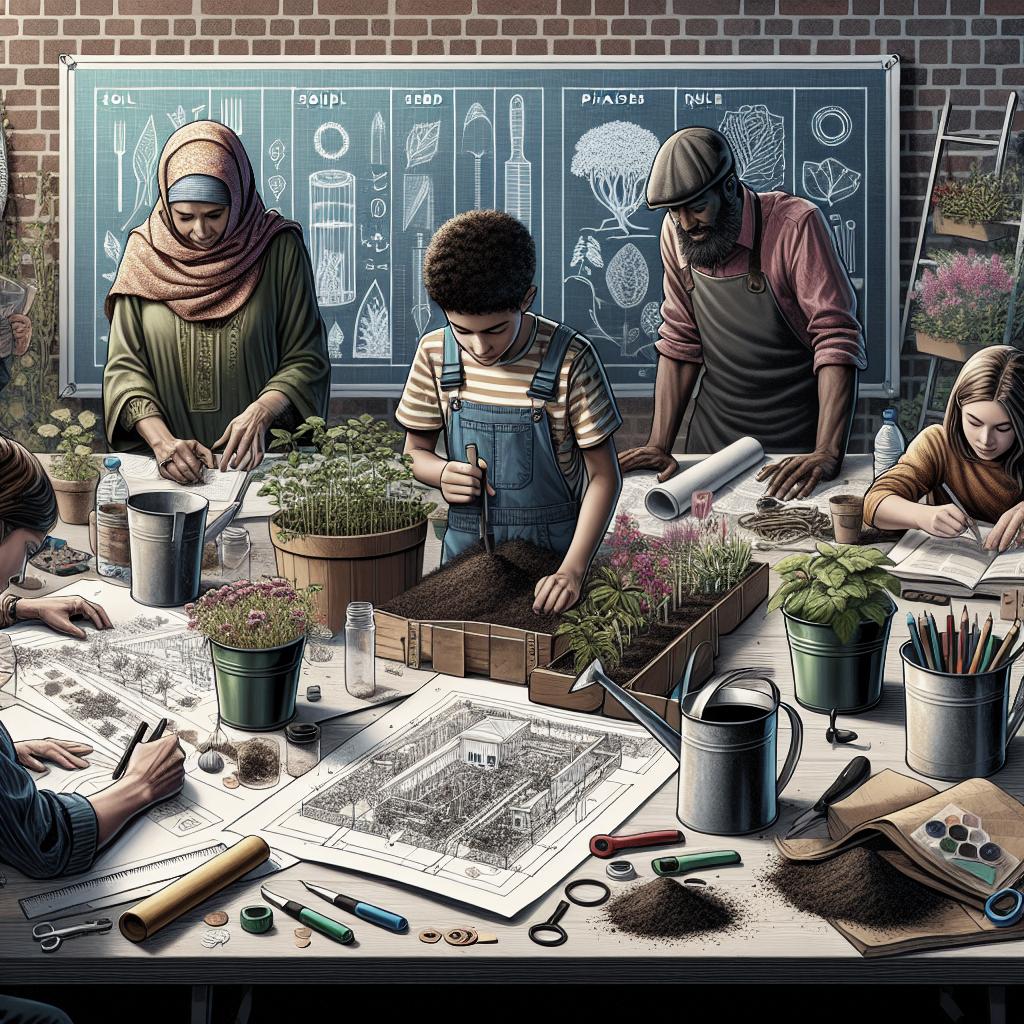Introduction: Build a Community Garden
Starting a community garden from scratch is a rewarding endeavor that brings people together, promotes sustainability, and enhances local food security. This comprehensive guide will take you through each step of the process, from initial preparation and building a community, to organizing the garden, and growing plants organically. You’ll learn about the importance of water access, utilizing waste effectively, building infrastructure, creating comfortable garden spaces, and more. By following these steps, you can transform an unused plot of land into a vibrant community oasis. Whether you’re using raised beds, dealing with limited space, or simply looking for efficient gardening techniques, this guide covers all aspects of starting and maintaining a successful community garden.
Step 1: Preparation
Starting with thorough preparation is crucial for the success of your community garden. Begin by identifying an appropriate plot of land. Consider factors such as soil quality, sunlight exposure, and proximity to water sources. Conducting a soil test will give you valuable information about any necessary amendments to optimize growing conditions. Additionally, secure any necessary permissions from local authorities or landowners. This might involve signing agreements or obtaining permits. Once you have the go-ahead, gather your materials and resources. This includes tools, seeds, and potentially, funds. Fundraising, grants, or sponsorships from local businesses can help to alleviate initial costs.
Building a Community
A community garden thrives on community involvement. Start by reaching out to neighbors, local organizations, and schools to generate interest. Host informational meetings to discuss the project and gather input. Get volunteers involved early on to foster a sense of ownership and commitment. Form a committee or group to manage the garden. Establish roles and responsibilities to ensure the garden’s sustainability. Planning regular meetings and social events will help maintain momentum and engagement. Collaboration and shared purpose are at the heart of a successful community garden.
Getting Water
Reliable access to water is essential for any garden. Assess your water options early on. If a municipal water supply is available, consider installing spigots or a simple irrigation system. Make sure to check local regulations regarding water usage. If municipal water isn’t an option, explore alternatives like rainwater harvesting systems. Collect and store rainwater using barrels or larger tanks, ensuring that gutters and downspouts are properly directed. Water conservation practices, such as mulching and choosing drought-resistant plants, can further reduce dependency on external water sources.
Use your Trash
One of the most sustainable practices in a community garden is composting. Turn organic waste from your kitchen and garden into valuable compost to enrich your soil. Set up a designated compost area with bins or heaps, making sure to balance green and brown materials. In addition to composting, consider repurposing materials for garden infrastructure. Old pallets can be transformed into garden beds, and discarded containers can serve as planters. By reducing waste and creatively reusing materials, you contribute to a more sustainable gardening environment.
Step 2: Organization
Organizing your garden plot effectively is vital for maximizing space and productivity. Start with a well-thought-out garden plan. Sketch a layout that includes pathways, growing areas, and communal spaces. Raised beds or defined rows can help to organize crops and improve accessibility. Set up a schedule for planting, watering, and maintenance tasks. Assign specific areas or plants to individual volunteers or groups to ensure that responsibilities are covered. A shared calendar or task list can help keep everyone on track and the garden thriving.
Step 3: Growing Organically
Embrace organic farming principles to support the health of your plants, soil, and the broader ecosystem. Avoid synthetic fertilizers and pesticides. Instead, use organic alternatives like compost, manure, or natural pest repellents. Companion planting is another effective practice. Certain plants benefit each other when grown together, deterring pests, and enhancing growth. Research which plants make good neighbors and incorporate them into your garden plan for optimal results.
Step 4: Soil
Healthy soil is the foundation of a successful garden. Regularly adding organic matter, such as compost or leaf mold, can improve soil structure and fertility. Conduct soil tests periodically to monitor pH levels and nutrient content, making necessary adjustments. Mulching is another important practice that helps retain soil moisture, suppress weeds, and gradually improve soil quality. Organic mulches, like straw or wood chips, break down over time, adding nutrients back into the soil.
Raised Bed Soil Recipe
Creating the right soil mix for raised beds is crucial. A recommended recipe includes a mix of one-third compost, one-third peat moss or coconut coir, and one-third vermiculite or coarse sand. This combination ensures good drainage, aeration, and nutrient availability. Fill your raised beds with this mix and periodically top up with fresh compost. This will maintain the soil’s fertility and structure, supporting healthy plant growth throughout the season. Regularly testing and amending the soil keeps it productive year after year.
Step 5: Infrastructure
Building sturdy infrastructure is essential for the longevity of your garden. Start with pathways that are wide enough for wheelbarrows and accessible for all gardeners. Use materials like gravel, mulch, or pavers for durability. Consider installing fencing to protect the garden from pests and vandals. A well-built fence can also add aesthetic value. Plan for shade structures, trellises, or greenhouses to extend the growing season and protect plants from harsh weather conditions.
Raised Beds
Raised beds provide many benefits, including improved soil control, better drainage, and easier access. Build your raised beds from rot-resistant wood, bricks, or other sturdy materials. Ensure they are at a comfortable height for all gardeners, especially those with mobility issues. Design beds that maximize space efficiency. Square foot gardening or intensive planting strategies can increase yields in limited space. Raised beds also warm up faster in the spring, giving plants an early start.
Irrigation System
Implementing an efficient irrigation system can save time and water. Drip irrigation or soaker hoses are excellent choices as they deliver water directly to the plant roots, minimizing evaporation and runoff. Automate your irrigation system with timers to ensure consistent watering, especially during dry spells. Regularly check and maintain the system to prevent leaks and clogs, ensuring it operates efficiently throughout the growing season.
Tool Shed
A well-organized tool shed is indispensable for any community garden. Construct a shed to store tools, supplies, and equipment, ensuring they are protected from the weather and easily accessible. Implement an inventory system to track tools and supplies. Label shelves and bins to keep the shed organized. Encourage gardeners to clean and return tools after use, maintaining an orderly and efficient space.
Step 6: Furniture
Adding furniture to your garden creates a welcoming space for relaxation and socializing. Consider installing benches, picnic tables, and chairs in shaded areas or scenic spots within the garden. Choose durable, weather-resistant materials for garden furniture. Encourage community art projects to decorate furniture, adding a personal touch. Creating comfortable seating areas promotes community interaction and enjoyment.
Step 7: Things We’ve Grown and Found in the Garden
Documenting the garden’s progress and harvests can be inspiring and informative. Create a log or blog to track the plants you’ve grown, their successes, and any challenges faced. Share stories and photos of unique finds or interesting experiences in the garden. Highlighting milestones and achievements fosters a sense of pride and accomplishment, encouraging continued participation and interest.
Step 8: You Don’t Need Land to Garden
Even without access to land, you can still enjoy gardening. Container gardening is a versatile option, allowing you to grow a variety of plants on balconies, patios, or windowsills. Choose containers that are large enough for root development and ensure they have proper drainage. Vertical gardening is another space-saving technique. Use trellises, shelves, or hanging planters to maximize growing area. Hydroponic systems can also be set up indoors, enabling you to grow plants without soil, using nutrient-rich water solutions.
Lessons Learned
| Step | Key Points |
|---|---|
| 1: Preparation | Identify land, secure permissions, gather materials, and fundraise. |
| Building a Community | Engage neighbors, form committees, and establish roles and responsibilities. |
| Getting Water | Ensure reliable water access via municipal supply or rainwater harvesting. |
| Use your Trash | Compost organic waste and repurpose materials for garden infrastructure. |
| 2: Organization | Plan layout, set schedule for tasks, and assign responsibilities. |
| 3: Growing Organically | Use organic practices, avoid synthetic chemicals, and implement companion planting. |
| 4: Soil | Enrich soil with organic matter, conduct soil tests, and mulch regularly. |
| Raised Bed Soil Recipe | Mix compost, peat moss/coir, and vermiculite/sand for ideal soil. |
| 5: Infrastructure | Build pathways, fences, shade structures, and greenhouses for garden longevity. |
| Raised Beds | Use rot-resistant materials, design for space efficiency, and tailor height for accessibility. |
| Irrigation System | Utilize drip irrigation or soaker hoses, automate with timers, and maintain system regularly. |
| Tool Shed | Construct a tool shed, implement an inventory system, and keep tools organized. |
| 6: Furniture | Add weather-resistant seating areas to create welcoming social spaces. |
| 7: Things We’ve Grown and Found in the Garden | Document harvests and experiences, share stories and photos to inspire the community. |
| 8: You Don’t Need Land to Garden | Explore container gardening, vertical gardening, and hydroponic systems indoors. |


